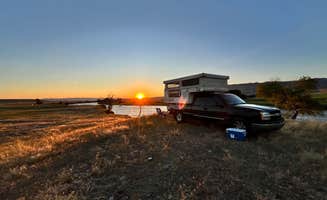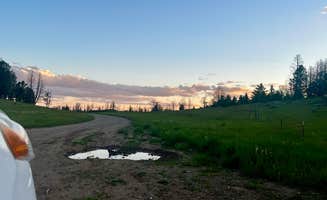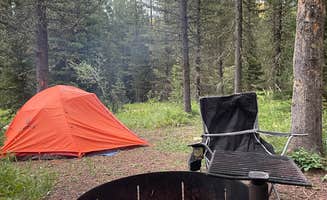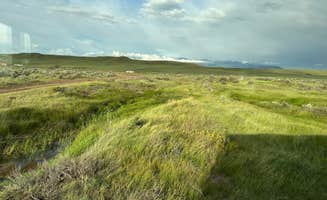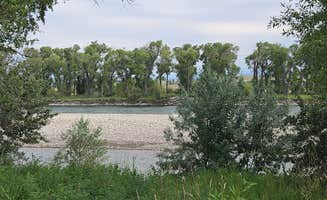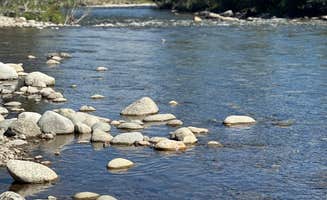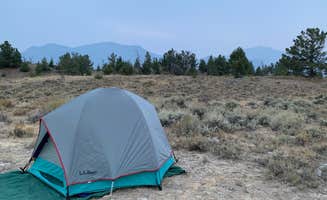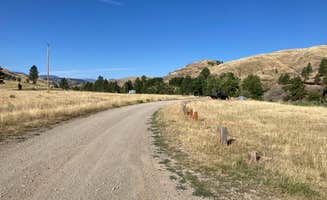Dispersed camping opportunities near Livingston, Montana extend beyond national forest lands to include fishing access sites along the Yellowstone River and reservoir camping locations. The area sits at elevations ranging from 4,500 feet in the valley to 9,000+ feet in the surrounding mountains, creating significant temperature variations even during summer months. Most primitive sites require visitors to pack out all trash and implement proper food storage techniques due to wildlife activity.
What to do
Fishing at multiple access points: Pig Farm Fishing Access Camp offers excellent Yellowstone River access. "There's also a great ramp for launching boats or kayaks or fishing from. Yellowstone on one side and beautiful mountains on the other and it's free!" reports one visitor. The site remains accessible year-round, though spring runoff can limit shoreline fishing.
Mountain biking on forest roads: The trails surrounding Hyalite Canyon Dispersed attract many cyclists. As one camper noted, "Very busy road with lots of mountain bikers and campers. Gorgeous canyon to camp in though!" The canyon provides both technical single-track and forest service roads suitable for beginners.
Wildlife observation opportunities: Early morning and evening hours offer the best wildlife viewing times across the area. At Cottonwood Reservoir, waterfowl migrations provide seasonal birding opportunities. One camper mentioned, "The reservoir has Yellowstone cutthroat trout and white suckers. All kinds of waterfowl passing seasonal."
What campers like
Riverside camping spots: The sound of flowing water ranks high among camper preferences. At Falls Creek, visitors appreciate the tranquil setting: "Each site is in the middle of trees and moss and directly next to the Boulder River. There is a picnic table and fire ring at each site." The campground offers walk-in tent camping with natural separation between sites.
Mountain views at sunrise/sunset: Fairy Lake Dispersed Camping provides dramatic mountain vistas. "There is a Meadow about 4 miles in front of the highway that has at least 3 dispersed sites. I went to the one furthest from the dirt road and had nice shade and privacy here," reports one camper. These sites allow visitors to experience alpenglow on the mountain peaks.
Solitude at higher elevations: Less-visited sites typically require rougher road travel but reward with fewer neighbors. One camper at Olson Creek noted, "Spent 3 nights here and aside from a few cars, main traffic coming through was a few dirt bikes and dune buggies and a few folks on bikes." Cell service remains surprisingly good at many higher elevation sites despite their remoteness.
What you should know
Road conditions require preparation: Many dispersed sites involve increasingly challenging access roads. At Olson Creek Dispersed, a visitor warned, "A bit confusing with all the no trespassing and no parking on/off the road signs. Felt more comfortable once we saw another van parked." Traveling with basic recovery equipment and checking recent reviews about road conditions prevents unwelcome surprises.
Train noise affects some sites: Railroad tracks parallel much of the Yellowstone River corridor, creating noise disturbances at riverside camping areas. A Pig Farm visitor reported, "Beautiful spot by the Yellowstone River. Train whistles woke us up four times." Sites further from the tracks in side canyons provide quieter alternatives.
Water sources vary seasonally: Hand pumps at developed sites like Falls Creek operate seasonally. "A hand pump water source is here. This is primitive camping in a cool little spot," notes one camper. Most dispersed sites require bringing all water needs or filtering from natural sources.
Tips for camping with families
Site selection for safety: Travertine Road Dispersed - Yellowstone offers relatively accessible camping with mountain views. "There are 3 or 4 spots in this area. I came in Labor Day weekend at 6:30 pm and was able to get a spot," reports one camper. Sites closest to the entrance provide easier emergency exits during weather events.
Wildlife teaching moments: While maintaining safe distances, camping near Livingston creates wildlife education opportunities. Cottonwood Reservoir visitors regularly report waterfowl sightings. Pack field guides specific to Rocky Mountain wildlife to help children identify tracks, scat, and birds.
Weather precautions: Afternoon thunderstorms develop quickly, particularly during summer months. Pack extra warm clothing even for summer trips, as temperature drops of 30+ degrees can occur within hours. One camper at Fairy Lake noted the need for preparation: "No bugs, no bear scat nearby, some traffic but still private."
Tips from RVers
Length restrictions matter: Most rustic camping locations near Livingston impose serious length limitations. At Battle Ridge Dispersed, a camper warned, "We followed the road all the way up to the end where it reaches private property. There is one spot just before. However it is a tight road, we had to unhook our trailer to turn around so it is not a place for big rigs."
Level site scarcity: Finding level parking for larger rigs presents challenges throughout the area. A visitor to Cottonwood Reservoir noted, "Most of the road is extremely rugged/uneven/full of large holes. The only place I was able to stay for the night was the road leading up to the locked gate."
Smaller trailers work best: RVers with compact setups report better experiences. At Falls Creek, one visitor observed, "There is enough space in the parking spaces to car camp but there is not enough space for larger rigs." Vehicle clearance proves more important than length for accessing many primitive sites.


